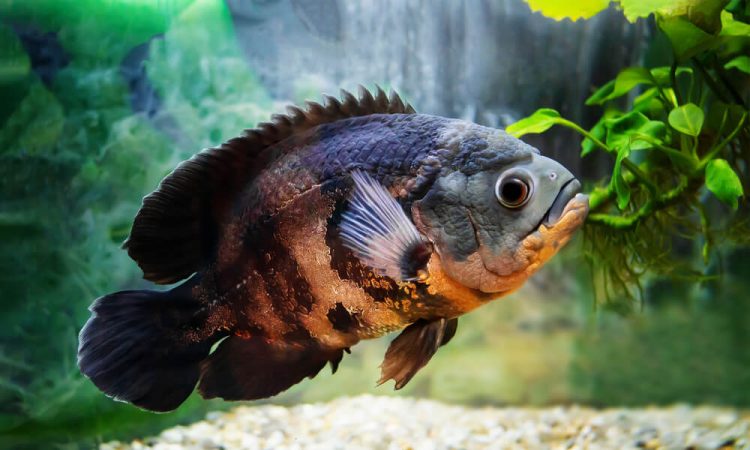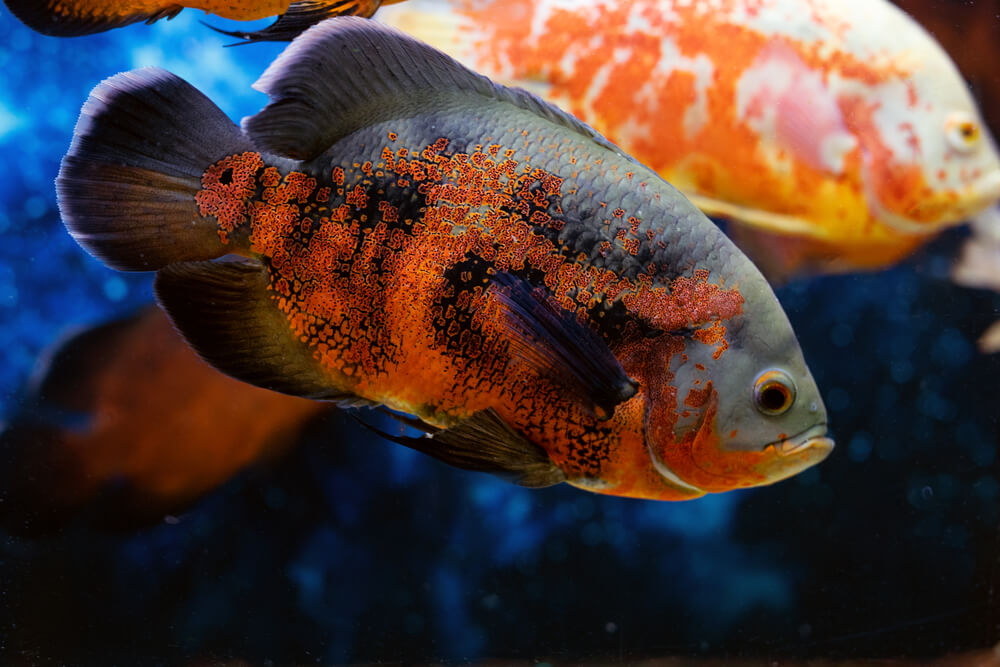
Oscar fish are popular for their striking colors and interactive personalities. Native to South America’s freshwater rivers, these intelligent fish are easy to care for, making them a favorite among hobbyists. This guide covers essential aspects of Oscar care: water conditions, tank setup, nutrition, health issues, and behaviors. This guide offers valuable insights to ensure your fish thrive.
What are Oscar Fish?
Oscar Fish, known scientifically as Astronotus ocellatus, are a species of cichlids that have captivated aquarium enthusiasts around the globe. Originating from the freshwater rivers and streams of South America, these vibrant fish are renowned for their striking coloration and engaging personalities.
As one of the most popular aquarium fish, Oscars come in various colors and patterns, including tiger, albino, and red varieties. They can grow quite large, up to 12 inches in length, making them a significant presence in any home aquarium.
Oscars are intelligent creatures with distinct behaviors that can be fascinating to observe. They often recognize their owners and can even be trained to perform simple tricks. However, they require a well-maintained environment with ample space due to their size and active nature.
In terms of care, Oscar Fish thrive in warm freshwater conditions with temperatures between 74-81°F (23-27°C). They are omnivorous but have a particular preference for protein-rich diets consisting of live or frozen foods like shrimp and insects.
Overall, Oscar Fish make for an engaging addition to any freshwater aquarium setup. Their unique characteristics not only add aesthetic value but also provide an interactive experience for hobbyists passionate about aquatic life.
Essential Tips for Keeping Your Oscars Healthy

Caring for Oscar fish requires a thorough understanding of their unique needs to ensure they thrive in your aquarium. Here are some essential tips to keep your Oscars healthy and vibrant.
Oscar Diet and Feeding
A balanced diet is crucial for the health of your Oscar fish. Oscars are omnivores, so their diet should include a mix of high-quality pellets, live foods such as worms and insects, and occasional vegetables like peas or spinach. It’s important to feed them twice a day and avoid overfeeding, as excess food can pollute the tank water.
Feeding Oscars
When feeding Oscars, it’s advisable to provide them with varied food sources to meet all their nutritional needs. Live foods can help mimic their natural hunting behavior, making feeding time both nutritious and engaging. Ensure that any live food is sourced from reputable suppliers to prevent introducing diseases into the tank.
Common Diseases in Oscar Fish
Like all fish species, Oscars are susceptible to certain diseases if not properly cared for. Common diseases in Oscar fish include Ich (white spot disease), Hole-in-the-Head disease (caused by poor water quality or lack of nutrients), and various bacterial infections. Regularly monitoring water quality and maintaining proper filtration can help prevent these ailments.
By following these essential tips on oscar fish care, you can create a healthy environment that allows your Oscars to flourish. Proper nutrition, regular tank maintenance, and vigilance against common diseases will ensure that your Oscar fish remain happy and healthy for years to come.
The Ideal Tank Setup for Oscar Fish
When setting up the ideal tank for Oscar fish, it’s essential to consider several key factors to ensure their health and well-being. First and foremost, the oscar tank size is crucial. Oscars are large, active fish that require ample space to thrive. A single adult oscar needs a minimum of a 55-gallon tank, but larger tanks of 75 gallons or more are preferable for multiple oscars or additional tank mates.
Speaking of oscar tank mates, it’s important to choose companions carefully. Oscars can be territorial and aggressive, so selecting similarly sized and temperamentally compatible species is vital. Potential tank mates include other large cichlids like Jack Dempseys or Green Terrors, as well as robust catfish such as Plecos.
Water conditions for oscars also play a significant role in their overall health. They prefer slightly acidic to neutral water with a pH range of 6.0-7.5 and temperatures between 74-81°F (23-27°C). Regular water changes and efficient filtration are necessary to maintain optimal water quality.
Finally, when considering the habitat setup for oscars, aim to replicate their natural environment. Use fine gravel or sand substrate and provide plenty of hiding spots with rocks and driftwood. Live plants can be included but may need protection from being uprooted by these energetic fish.
By paying close attention to these aspects you’ll create an ideal environment where your Oscar fish can flourish.
Feeding Your Oscar Fish
Oscar fish, known for their vibrant colors and engaging personalities, require a well-balanced diet to thrive. Understanding the dietary needs of oscar fish is crucial for their health and longevity.
Oscar feeding schedules should be consistent to maintain optimal health. It’s recommended to feed adult oscars once or twice a day, while juvenile oscars may need more frequent feedings, up to three times daily. Overfeeding can lead to obesity and water quality issues, so it’s important to provide only what they can consume within a few minutes.
When it comes to the best food for oscars, variety is key. High-quality cichlid pellets form the staple of their diet due to their balanced nutritional content. Supplement these with live or frozen foods such as bloodworms, brine shrimp, and feeder fish like guppies or goldfish to mimic their natural hunting behavior and provide essential proteins.
Vegetables also play an important role in the dietary needs of oscar fish. Blanched peas, spinach, and zucchini can be offered occasionally for added fiber and nutrients. Additionally, incorporating vitamin supplements into their diet can help prevent deficiencies.
By adhering to these guidelines on oscar feeding schedules and providing a diverse diet rich in nutrients, you ensure your oscar fish remain healthy and vibrant throughout their lives.
Common Health Issues in Oscar Fish and How to Address Them
Oscar fish are known for their vibrant colors and engaging personalities, making them a popular choice among aquarium enthusiasts. However, like any pet, they are susceptible to various health issues. Understanding common diseases in Oscar fish and how to address them is crucial for maintaining their well-being.
One of the most prevalent health issues in Oscar fish is Ich, also known as white spot disease. This parasitic infection manifests as small white spots on the fish’s body and fins. Signs of illness in oscars with Ich include scratching against objects, rapid breathing, and lethargy. Treating sick oscars with Ich involves raising the tank temperature gradually to around 86°F (30°C) and adding an appropriate anti-parasitic treatment.
Another common ailment is Hole-in-the-Head Disease (HITH), which appears as pitted lesions on the head and along the lateral line of the fish. Poor water quality and nutritional deficiencies often contribute to this condition. To address HITH, ensure optimal water conditions by performing regular water changes and using activated carbon filters to remove impurities. Additionally, provide a balanced diet rich in vitamins and minerals.
Fin rot is another issue that can affect Oscar fish, characterized by frayed or disintegrating fins caused by bacterial infections or poor water quality. Maintaining clean tank conditions and administering antibacterial treatments can help treat fin rot effectively.
By recognizing these signs of illness in oscars early on and taking appropriate measures for treating sick oscars, you can ensure your aquatic friends remain healthy and vibrant. Regular monitoring of water quality, providing a nutritious diet, and observing your Oscars’ behavior are key practices in preventing diseases in Oscar fish.
A Step-by-Step to Guide Breeding Oscar Fish
Breeding Oscars at home can be a rewarding experience for both novice and experienced aquarists. These vibrant, intelligent fish are known for their distinctive personalities and beautiful coloration. Here’s a step-by-step guide to help you successfully breed your Oscars.
1. Setting Up the Breeding Tank: Start by preparing a separate breeding tank to ensure the best environment for your Oscars. The tank should be at least 75 gallons, providing ample space for the pair. Maintain water parameters with a pH of 6.5-7.2 and a temperature of 78-82°F.
2. Selecting the Breeding Pair: Choose a healthy male and female Oscar that are at least 18 months old, as they reach sexual maturity around this age. Look for signs of readiness such as increased interaction between the pair and territorial behavior.
3. Conditioning the Pair: Before breeding, condition your Oscars by feeding them high-quality foods rich in protein, such as live or frozen brine shrimp and bloodworms. This diet will enhance their health and increase spawning success.
4. Spawning Process: Once conditioned, place the pair in the breeding tank with flat surfaces like slate or smooth rocks where they can lay eggs. The female will lay hundreds of eggs on these surfaces, which the male will then fertilize.
5. Egg Care: After spawning, it’s crucial to monitor water quality closely to prevent fungal infections on eggs. You may also consider using methylene blue as an antifungal treatment if necessary.
6. Fry Care for Oscillating Cichlids: Once hatched, fry care is paramount for their survival and growth:
- Remove parents from the tank if they show signs of aggression towards fry.
- Feed fry with infusoria or commercially available liquid fry food initially.
- Gradually introduce baby brine shrimp or finely crushed flake food as they grow.
By following these oscar breeding tips meticulously, you can enjoy watching your oscillating cichlids thrive from eggs to fully-grown fish in your home aquarium!
The Behavioral Traits of Oscar Fish You Should Know About
Oscar fish, known for their striking appearance and vibrant colors, exhibit a range of fascinating behavioral traits that are important for any aquarist to understand. One notable aspect of oscar temperament is their territorial nature. Oscars are known to establish and defend territories within their tank, which can sometimes lead to aggressive interactions with other fish. This territorial behavior is more pronounced if the tank is overcrowded or if there are insufficient hiding spots.
The social behavior of oscars also includes a surprising level of intelligence and curiosity. These fish often recognize their owners and may even interact with them through the glass, showcasing a unique bond uncommon in many other fish species. However, while they can be quite personable with humans, they may not always be as friendly with tank mates. It’s crucial to carefully select compatible species when housing oscars with other fish.
Oscars also display interesting feeding behaviors; they are enthusiastic eaters and can become quite excited during feeding times. This excitement is another sign of their interactive nature but requires careful monitoring to prevent overfeeding or aggression during meal times.
Understanding these key aspects of oscar temperament and social behavior can greatly enhance the experience of keeping these captivating fish, ensuring a harmonious and healthy aquarium environment for all inhabitants.
Enjoying the Benefits of Keeping Vibrant and Energetic Oscars
In conclusion, maintaining vibrant and energetic Oscars in your aquarium is not only rewarding but also beneficial for the overall health of your aquatic ecosystem. These colorful and lively fish bring a unique charm to any tank, making them a favorite among fish enthusiasts. To ensure your Oscars thrive, it’s essential to provide them with a balanced diet, regular water changes, and an adequately sized tank.
Additionally, monitoring water parameters such as pH levels and temperature can significantly impact their well-being. By creating an environment that mimics their natural habitat, you allow these magnificent creatures to exhibit their full range of behaviors and colors.
Incorporating plants and hiding spots within the aquarium can also enhance their living conditions, offering both stimulation and security. Regular observation will help you detect any signs of illness early on, enabling prompt action to maintain their health.
Overall, the effort invested in caring for Oscars is well worth it. Their dynamic presence not only enhances the visual appeal of your aquarium but also contributes positively to the aquatic community they share with other species. Enjoying the benefits of keeping vibrant and energetic Oscars ultimately leads to a more fulfilling aquarist experience.




